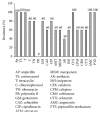Isolation and Antibiotic Susceptibility of the Microorganisms Isolated from Diabetic Foot Infections in Nemazee Hospital, Southern Iran
- PMID: 26843987
- PMCID: PMC4710915
- DOI: 10.1155/2015/328796
Isolation and Antibiotic Susceptibility of the Microorganisms Isolated from Diabetic Foot Infections in Nemazee Hospital, Southern Iran
Abstract
Background. Diabetic foot infections (DFIs) are a major public health issue and identification of the microorganisms causing such polymicrobial infections is useful to find out appropriate antibiotic therapy. Meanwhile, many reports have shown antibiotic resistance rising dramatically. In the present study, we sought to determine the prevalence of microorganisms detected on culture in complicated DFIs in hospitalized patients and their antibiotic sensitivity profiles. Methods. A cross-sectional study was conducted for a period of 24 months from 2012 to 2014 in Nemazee Hospital, Shiraz, Iran. The demographic and clinical features of the patients were obtained. Antimicrobial susceptibility testing to different agents was carried out using the disc diffusion method. Results. During this period, 122 aerobic microorganisms were isolated from DFIs. Among Gram-positive and Gram-negative bacteria, Staphylococcus spp. and E. coli were the most frequent organisms isolated, respectively. Of the isolates, 91% were multidrug while 78% of S. aureus isolates were methicillin resistant. 53% of Gram-negative bacteria were positive for extended-spectrum β-lactamase. Conclusion. Given the involvement of different microorganisms and emergence of multidrug resistant strains, clinicians are advised to consider culture before initiation of empirical therapy.
Figures
Similar articles
-
Identification and antibiotic susceptibility of microorganisms isolated from diabetic foot ulcers: A pathological aspect.Exp Ther Med. 2022 Dec 7;25(1):53. doi: 10.3892/etm.2022.11752. eCollection 2023 Jan. Exp Ther Med. 2022. PMID: 36588808 Free PMC article.
-
Microbiological Pattern, Antimicrobial Resistance and Prevalence of MDR/XDR Organisms in Patients With Diabetic Foot Infection in an Indian Tertiary Care Hospital.Int J Low Extrem Wounds. 2023 Dec;22(4):695-703. doi: 10.1177/15347346211038090. Epub 2021 Aug 12. Int J Low Extrem Wounds. 2023. PMID: 34382450
-
Bacteriology of moderate-to-severe diabetic foot infections in two tertiary hospitals of Iran.Foot (Edinb). 2019 Sep;40:54-58. doi: 10.1016/j.foot.2019.05.001. Epub 2019 May 10. Foot (Edinb). 2019. PMID: 31102964
-
Emerging issues in the diagnosis and management of infections caused by multi-drug-resistant, gram-positive cocci.Surg Infect (Larchmt). 2005;6 Suppl 2:S-5-22. Surg Infect (Larchmt). 2005. PMID: 23577494 Review.
-
Novel antibiotics for the management of diabetic foot infections.Int J Antimicrob Agents. 2008 May;31(5):411-9. doi: 10.1016/j.ijantimicag.2007.10.016. Epub 2007 Dec 26. Int J Antimicrob Agents. 2008. PMID: 18155884 Review.
Cited by
-
Identification and antibiotic susceptibility of microorganisms isolated from diabetic foot ulcers: A pathological aspect.Exp Ther Med. 2022 Dec 7;25(1):53. doi: 10.3892/etm.2022.11752. eCollection 2023 Jan. Exp Ther Med. 2022. PMID: 36588808 Free PMC article.
-
The microbiology of diabetic foot infections: a meta-analysis.BMC Infect Dis. 2021 Aug 9;21(1):770. doi: 10.1186/s12879-021-06516-7. BMC Infect Dis. 2021. PMID: 34372789 Free PMC article.
-
Multidrug resistant organism predicts ulcer recurrence following surgical management of diabetic foot osteomyelitis.Int Wound J. 2020 Dec;17(6):1634-1641. doi: 10.1111/iwj.13439. Epub 2020 Jul 7. Int Wound J. 2020. PMID: 32633880 Free PMC article.
-
Bacteriological Profile and Antibiotic Susceptibility Pattern of Diabetic Foot Infection in a Tertiary Care Hospital in Lampung, Indonesia.Malays J Med Sci. 2021 Oct;28(5):42-53. doi: 10.21315/mjms2021.28.5.4. Epub 2021 Oct 26. Malays J Med Sci. 2021. PMID: 35115886 Free PMC article.
-
Molecular Characteristics of Methicillin-Resistant Staphylococcus aureus (MRSA) Isolated from Diabetic Foot Infection.Iran J Pathol. 2019 Fall;14(4):329-337. doi: 10.30699/ijp.2019.101092.2035. Epub 2019 Sep 22. Iran J Pathol. 2019. PMID: 31754364 Free PMC article.
References
-
- Larijani B., Ranjbar S. H. Overview of diabetic foot; novel treatments in diabetic foot ulcer. DARU. 2008;16(supplement 1):1–6.
LinkOut - more resources
Full Text Sources
Other Literature Sources
Miscellaneous



